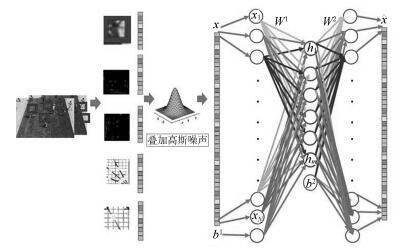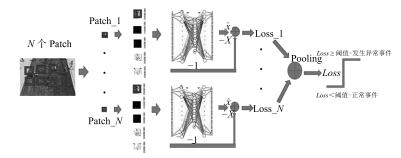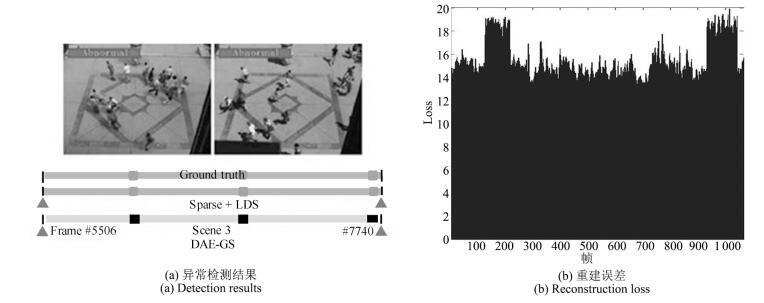Application of Sparse Denoising Auto Encoder Network with Gradient Difference Information for Abnormal Action Detection
-
摘要: 本文是在稀疏去噪自编码网络的基础上,增加梯度差约束条件改进了自编码网络的解码效果,并成功地应用于全局异常行为检测的领域.基于稀疏自编码网络异常行为的检测过程是通过训练非异常行为的视频帧数据得到自编码网络模型,将待测视频帧输入模型,根据前向传播算法得到模型的输出,计算输出与输入之间的损失值,当该值高于某个阈值时,判定该视频帧中存在异常行为.通过在标准异常行为库开展的实验表明融合梯度差信息的稀疏去噪自编码网络算法较传统的稀疏去噪自编码网络算法在全局异常行为检测中更加有效.Abstract: The paper proposes an improved sparse denoising auto encoder network by adding a gradient difference constraint, which has been successfully applied to frame-level abnormal action detection. Firstly, the abnormal action detection algorithm is trained using normal frames in video to get an auto encoder network model. Then after inputting a test frame into the network model, the forward propagation algorithm is used to get the output. Finally, if the loss between input data and output data is higher than a threshold, then it is concluded that some abnormal action shave occurred in the test frame. Experimental results on UMN datasets show that the improved network with gradient difference information is more effective than the traditional one in global abnormality detection.
-
Key words:
- Auto encoder /
- sparse coding /
- gradient difference /
- abnormal action
-
表 1 DAE算法与DAE-GS算法的实验结果
Table 1 Detecting results with DAE and DAE-GS algorithms
隐层神经元
数量 ($ {2^N} $)S1 (DAE-GS) S1 (DAE) S2 (DAE-GS) S2 (DAE) S3 (DAE-GS) S3 (DAE) 4 0.9643 0.9444 0.9934 0.9898 0.9568 0.9299 5 0.9446 0.9383 0.9844 0.9959 0.9755 0.9029 6 0.9391 0.9229 0.9611 0.9917 0.9455 0.9639 7 0.9533 0.9548 0.9900 0.9823 (0.9867) 0.9214 8 0.9512 0.9177 0.9985 0.9913 0.9712 0.9135 9 0.9541 0.9520 0.9936 0.9966 0.9720 0.8870 10 0.9576 0.9516 0.9932 0.9956 0.9824 0.9319 11 0.9683 0.9354 0.9915 0.9963 0.9527 0.9457 12 0.9716 0.9365 0.9977 0.9869 0.9722 0.9667 13 0.9734 0.9249 0.9985 0.9973 0.9474 0.8770 14 (0.9810) 0.9242 (0.9987) 0.9902 0.9840 0.9607 15 0.9736 0.9401 0.9982 0.9947 0.9753 0.9464 表 2 与当前流行算法之间的正确率的比较
Table 2 Recognition accuracies compared with state of art methods
算法 场景1 场景2 场景3 Sparse $\mathit{0}\mathit{.995} $ 0.975 0.964 Sparse + LSDS $\boldsymbol{0.9955} $ 0.971 0.974 DAE 0.957 $ \boldsymbol{0.998} $ 0.966 DAE-GS 0.981 $\boldsymbol{(0.998)} $ $\boldsymbol{(0.986)} $ 表 3 不同算法的时间复杂性比较 (ms)
Table 3 Comparison of difierent methods in terms of computational time (ms)
算法 训练时间 整体测试时间 单帧测试时间 Sparse 12 410 6 890 6.56 DAE 12 403 7 100 6.76 DAE-GS 20 210 9 034 8.60 -
[1] Hu X, Hu S Q, Zhang X Y, Zhang H L, Luo L K. Anomaly detection based on local nearest neighbor distance descriptor in crowded scenes. The Scientific World Journal, 2014, 2014:Article ID 632575 [2] Li W X, Mahadevan V, Vasconcelos N. Anomaly detection and localization in crowded scenes. IEEE Transactions on Pattern Analysis and Machine Intelligence, 2014, 36(1):18-32 doi: 10.1109/TPAMI.2013.111 [3] Yuan Y, Fang J W, Wang Q. Online anomaly detection in crowd scenes via structure analysis. IEEE Transactions on Cybernetics, 2015, 45(3):548-561 doi: 10.1109/TCYB.2014.2330853 [4] Mehran R, Oyama A, Shah M. Abnormal crowd behavior detection using social force model. In:Proceedings of the 2009 IEEE Conference on Computer Vision and Pattern Recognition. Florida, USA:IEEE, 2009. 935-942 [5] Cui X Y, Liu Q S, Gao M C, Metaxas D N. Abnormal detection using interaction energy potentials. In:Proceedings of the 2011 IEEE Conference on Computer Vision and Pattern Recognition. Providence, RI, USA:IEEE, 2011. 3161-3167 [6] Adam A, Rivlin E, Shimshoni I, Reinitz D. Robust real-time unusual event detection using multiple fixed-location monitors. IEEE Transactions on Pattern Analysis and Machine Intelligence, 2008, 30(3):555-560 doi: 10.1109/TPAMI.2007.70825 [7] Wu S D, Moore B E, Shah M. Chaotic invariants of lagrangian particle trajectories for anomaly detection in crowded scenes. In:Proceedings of the 2010 IEEE Conference on Computer Vision and Pattern Recognition. San Francisco, USA:IEEE, 2010. 2054-2060 [8] Antić B, Ommer B. Video parsing for abnormality detection. In:Proceedings of the 2011 International Conference on Computer Vision. Barcelona, Spain:IEEE, 2011. 2415-2422 [9] Kim J, Grauman K. Observe locally, infer globally:a space-time MRF for detecting abnormal activities with incremental updates. In:Proceedings of the 2009 IEEE Conference on Computer Vision and Pattern Recognition. Florida, USA:IEEE, 2009. 2921-2928 [10] 练秋生, 石保顺, 陈书贞.字典学习模型、算法及其应用研究进展.自动化学报, 2015, 41(2):240-260 http://www.aas.net.cn/CN/abstract/abstract18604.shtmlLian Qiu-Sheng, Shi Bao-Shun, Chen Shu-Zhen. Research advances on dictionary learning models, algorithms and applications. Acta Automatica Sinica, 2015, 41(2):240-260 http://www.aas.net.cn/CN/abstract/abstract18604.shtml [11] 汤红忠, 张小刚, 陈华, 程炜, 唐美玲.带边界条件约束的非相干字典学习方法及其稀疏表示.自动化学报, 2015, 41(2):312-319 http://www.aas.net.cn/CN/abstract/abstract18610.shtmlTang Hong-Zhong, Zhang Xiao-Gang, Chen Hua, Cheng Wei, Tang Mei-Ling. Incoherent dictionary learning method with border condition constrained for sparse representation. Acta Automatica Sinica, 2015, 41(2):312-319 http://www.aas.net.cn/CN/abstract/abstract18610.shtml [12] 刘培娜, 刘国军, 郭茂祖, 刘扬, 李盼.非负局部约束线性编码图像分类算法.自动化学报, 2015, 41(7):1235-1243 http://www.aas.net.cn/CN/abstract/abstract18697.shtmlLiu Pei-Na, Liu Guo-Jun, Guo Mao-Zu, Liu Yang, Li Pan. Image classification based on non-negative locality-constrained linear coding. Acta Automatica Sinica, 2015, 41(7):1235-1243 http://www.aas.net.cn/CN/abstract/abstract18697.shtml [13] Cong Y, Yuan J S, Liu J. Sparse reconstruction cost for abnormal event detection. In:Proceedings of the 2011 IEEE Conference on Computer Vision and Pattern Recognition. Providence, RI, USA:IEEE, 2011. 3449-3456 [14] Cong Y, Yuan J S, Liu J. Abnormal event detection in crowded scenes using sparse representation. Pattern Recognition, 2013, 46(7):1851-1864 doi: 10.1016/j.patcog.2012.11.021 [15] Zhang T Z, Ghanem B, Liu S, Ahuja N. Robust visual tracking via structured multi-task sparse learning. International Journal of Computer Vision, 2013, 101(2):367-383 doi: 10.1007/s11263-012-0582-z [16] Zhu X B, Liu J, Wang J Q, Li C S, Lu H Q. Sparse representation for robust abnormality detection in crowded scenes. Pattern Recognition, 2014, 47(5):1791-1799 doi: 10.1016/j.patcog.2013.11.018 [17] Vincent P, Larochelle H, Lajoie I, Bengio Y, Manzagol P A. Stacked denoising autoencoders:learning useful representations in a deep network with a local denoising criterion. The Journal of Machine Learning Research, 2010, 11:3371-3408 http://research2.fit.edu/ice/?q=node/225 -





 下载:
下载:





